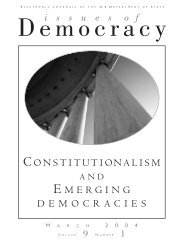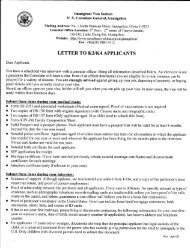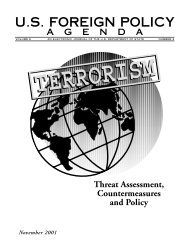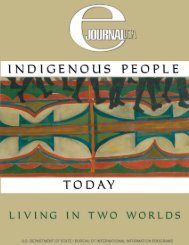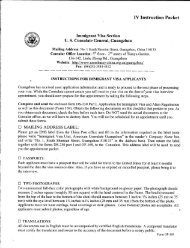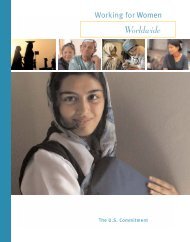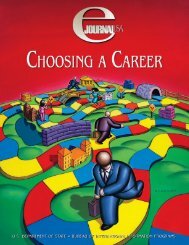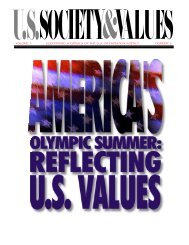s. history us history us history - Embassy of the United States
s. history us history us history - Embassy of the United States
s. history us history us history - Embassy of the United States
- No tags were found...
Create successful ePaper yourself
Turn your PDF publications into a flip-book with our unique Google optimized e-Paper software.
CHAPTER 4: THE FORMATION OF A NATIONAL GOVERNMENTOUTLINE OF U.S. HISTORYbalancing sectional economic interests;for settling arguments as to<strong>the</strong> powers, term, and selection <strong>of</strong><strong>the</strong> chief executive; and for solvingproblems involving <strong>the</strong> tenure <strong>of</strong>judges and <strong>the</strong> kind <strong>of</strong> courts to beestablished.Laboring through a hot Philadelphiasummer, <strong>the</strong> convention finallyachieved a draft incorporating ina brief document <strong>the</strong> organization<strong>of</strong> <strong>the</strong> most complex governmentyet devised, one that would be supremewithin a clearly defined andlimited sphere. It would have fullpower to levy taxes, borrow money,establish uniform duties and excisetaxes, coin money, regulate interstatecommerce, fix weights andmeasures, grant patents and copyrights,set up post <strong>of</strong>fices, and buildpost roads. It also was authorized toraise and maintain an army andnavy, manage Native American affairs,conduct foreign policy, andwage war. It could pass laws fornaturalizing foreigners and controllingpublic lands; it could admit newstates on a basis <strong>of</strong> absolute equalitywith <strong>the</strong> old. The power to pass allnecessary and proper laws for executing<strong>the</strong>se clearly defined powersrendered <strong>the</strong> federal governmentable to meet <strong>the</strong> needs <strong>of</strong> later generationsand <strong>of</strong> a greatly expandedbody politic.The principle <strong>of</strong> separation <strong>of</strong>powers had already been given a fairtrial in most state constitutions andhad proved sound. Accordingly, <strong>the</strong>convention set up a governmentalsystem with separate legislative,executive, and judiciary branches,each checked by <strong>the</strong> o<strong>the</strong>rs. Th<strong>us</strong>congressional enactments were notto become law until approved by<strong>the</strong> president. And <strong>the</strong> presidentwas to submit <strong>the</strong> most important<strong>of</strong> his appointments and all his treatiesto <strong>the</strong> Senate for confirmation.The president, in turn, could be impeachedand removed by Congress.The judiciary was to hear all casesarising under federal laws and <strong>the</strong>Constitution; in effect, <strong>the</strong> courtswere empowered to interpret both<strong>the</strong> fundamental and <strong>the</strong> statutelaw. But members <strong>of</strong> <strong>the</strong> judiciary,appointed by <strong>the</strong> president and confirmedby <strong>the</strong> Senate, could also beimpeached by Congress.To protect <strong>the</strong> Constitution fromhasty alteration, Article V stipulatedthat amendments to <strong>the</strong> Constitutionbe proposed ei<strong>the</strong>r by twothirds<strong>of</strong> both ho<strong>us</strong>es <strong>of</strong> Congress orby two-thirds <strong>of</strong> <strong>the</strong> states, meetingin convention. The proposals were tobe ratified by one <strong>of</strong> two methods:ei<strong>the</strong>r by <strong>the</strong> legislatures <strong>of</strong> threefourths<strong>of</strong> <strong>the</strong> states, or by conventionin three-fourths <strong>of</strong> <strong>the</strong> states,with <strong>the</strong> Congress proposing <strong>the</strong>method to be <strong>us</strong>ed.Finally, <strong>the</strong> convention faced<strong>the</strong> most important problem <strong>of</strong> all:How should <strong>the</strong> powers given to<strong>the</strong> new government be enforced?Under <strong>the</strong> Articles <strong>of</strong> Confederation,<strong>the</strong> national government hadpossessed — on paper — significantpowers, which, in practice, hadcome to naught, for <strong>the</strong> states paidno attention to <strong>the</strong>m. What was tosave <strong>the</strong> new government from <strong>the</strong>same fate?At <strong>the</strong> outset, most delegates furnisheda single answer — <strong>the</strong> <strong>us</strong>e <strong>of</strong>force. But it was quickly seen that <strong>the</strong>application <strong>of</strong> force upon <strong>the</strong> stateswould destroy <strong>the</strong> Union. The decisionwas that <strong>the</strong> government shouldnot act upon <strong>the</strong> states but upon <strong>the</strong>people within <strong>the</strong> states, and shouldlegislate for and upon all <strong>the</strong> individualresidents <strong>of</strong> <strong>the</strong> country. As<strong>the</strong> keystone <strong>of</strong> <strong>the</strong> Constitution, <strong>the</strong>convention adopted two brief buthighly significant statements:Congress shall have power ...to make all Laws which shall benecessary and proper for carryinginto Execution <strong>the</strong> ... Powersvested by this Constitution in <strong>the</strong>Government <strong>of</strong> <strong>the</strong> <strong>United</strong> <strong>States</strong>.... (Article I, Section 7)This Constitution, and <strong>the</strong>Laws <strong>of</strong> <strong>the</strong> <strong>United</strong> <strong>States</strong> whichshall be made in Pursuance<strong>the</strong>re<strong>of</strong>; and all Treaties made, orwhich shall be made, under <strong>the</strong>Authority <strong>of</strong> <strong>the</strong> <strong>United</strong> <strong>States</strong>,shall be <strong>the</strong> supreme Law <strong>of</strong> <strong>the</strong>Land; and <strong>the</strong> Judges in everyState shall be bound <strong>the</strong>reby,any Thing in <strong>the</strong> Constitution orLaws <strong>of</strong> any State to <strong>the</strong> Contrarynotwithstanding. (Article VI)Th<strong>us</strong> <strong>the</strong> laws <strong>of</strong> <strong>the</strong> <strong>United</strong> <strong>States</strong>became enforceable in its own nationalcourts, through its own judgesand marshals, as well as in <strong>the</strong> statecourts through <strong>the</strong> state judges andstate law <strong>of</strong>ficers.Debate continues to this dayabout <strong>the</strong> motives <strong>of</strong> those whowrote <strong>the</strong> Constitution. In 1913 historianCharles Beard, in An EconomicInterpretation <strong>of</strong> <strong>the</strong> Constitution,argued that <strong>the</strong> Founding Fa<strong>the</strong>rsrepresented emerging commercial-capitalistinterests that neededa strong national government. Healso believed many may have beenmotivated by personal holdings <strong>of</strong>large amounts <strong>of</strong> depreciated governmentsecurities. However, JamesMadison, principal drafter <strong>of</strong> <strong>the</strong>Constitution, held no bonds andwas a Virginia planter. Conversely,some opponents <strong>of</strong> <strong>the</strong> Constitutionowned large amounts <strong>of</strong> bondsand securities. Economic interestsinfluenced <strong>the</strong> course <strong>of</strong> <strong>the</strong> debate,but so did state, sectional, and ideologicalinterests. Equally importantwas <strong>the</strong> idealism <strong>of</strong> <strong>the</strong> framers.Products <strong>of</strong> <strong>the</strong> Enlightenment, <strong>the</strong>Founding Fa<strong>the</strong>rs designed a governmentthat <strong>the</strong>y believed wouldpromote individual liberty andpublic virtue. The ideals embodiedin <strong>the</strong> U.S. Constitution remain anessential element <strong>of</strong> <strong>the</strong> Americannational identity.RATIFICATION ANDTHE BILL OF RIGHTSOn September 17, 1787, after 16weeks <strong>of</strong> deliberation, <strong>the</strong> finishedConstitution was signed by 39 <strong>of</strong><strong>the</strong> 42 delegates present. Franklin,pointing to <strong>the</strong> half-sun painted inbrilliant gold on <strong>the</strong> back <strong>of</strong> Washington’schair, said:7475



